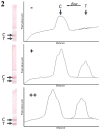A rapid test for soy aeroallergens exposure assessment
- PMID: 24533134
- PMCID: PMC3923041
- DOI: 10.1371/journal.pone.0088676
A rapid test for soy aeroallergens exposure assessment
Abstract
Background: Determining soy aeroallergens levels is extremely important in the assessment of health risks due to these airborne substances. Currently, soy aeroallergens exposure in the environment is monitored using enzyme immunoassays (EIA) which must be evaluated in a specialized laboratory by skilled personnel.
Objective: To describe the development and performance of a rapid immunochromatography assay for the detection of soy aeroallergens in environmental samples.
Methods: A test strip using gold labeled anti-soy hull low molecular weight extract (SHLMWE) antibody for the rapid detection of soy aeroallergens in environmental samples was developed. One hundred nineteen airborne samples were analysed in parallel by the strip assay and the anti-SHLMWE sandwich EIA. The assay results were visually analysed by three independent observers who ranked samples as: -, + or ++. Strips were also scanned and analysed by densitometry.
Results: The rapid test detected a range of concentrations from 6.25 to 25 ng/mL. Agreement in strip assay interpretations between evaluators was substantial (Kappa = 0.63; CI 0.544-0.715). Visual interpretation also gave a good concordance with EIA results, with sensitivity ranging from 77.3 to 100 and specificity from 65 to 83.5 depending on the observer. Furthermore, a strong correlation was observed between densitometry results of strip assay and EIA determinations.
Conclusions: The strip assay developed is rapid, simple, and sensitive and does not require expensive equipment or specific skills. It has considerable potential in the environmental monitoring field for screening soy aeroallergens levels in port cities where allergen measurements are not currently performed. Due to its simplicity, the test will improve the management of soy allergic patients by controlling environmental allergen exposure without the need for apparatus or skilled personnel.
Conflict of interest statement
Figures




References
-
- Anto JM, Sunyer J, Rodriguez-Roisin R, Suarez-Cervera M, Vazquez L (1989) Community outbreaks of asthma associated with inhalation of soybean dust. Toxicoepidemiological Committee. N Engl J Med 320(17): 1097–1102. - PubMed
-
- Ballester F, Soriano JB, Otero I, Rivera ML, Sunyer J, et al. (1999) Asthma visits to emergency rooms and soybean unloading in the harbors of Valencia and A Coruna, Spain. Am J Epidemiol 149(4): 315–322. - PubMed
-
- White MC, Etzel RA, Olson DR, Goldstein IF (1997) Reexamination of epidemic asthma in New Orleans, Louisiana, in relation to the presence of soy at the harbor. Am J Epidemiol 145(5): 432–438. - PubMed
-
- Navarro C, Marquez M, Hernando L, Galvan F, Zapatero L, et al. (1993) Epidemic asthma in Cartagena, Spain, and its association with soybean sensitivity. Epidemiology 4(1): 76–79. - PubMed
-
- Garcia-Ortega P, Rovira E, Mora E (1997) Soy-seed asthma epidemics in small cities. Med Clin (Barc) 108(17): 677. - PubMed
Publication types
MeSH terms
Substances
LinkOut - more resources
Full Text Sources
Other Literature Sources

